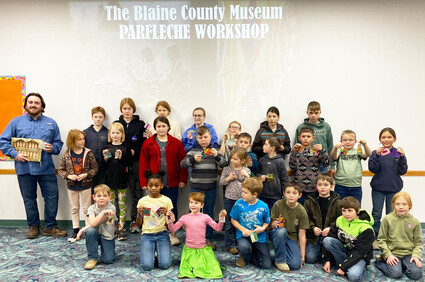Homeschool Hour students learn about parfleche and how it was decorated
December 13, 2023

Emily Scofield
These students are holding up pieces of parfleche they decorated at Homeschool Hour at the Blaine County Library. Homeschool Hour meets from 1-2 pm each Wednesday. The program about parfleche was taught by Austin Haney, a former Interpretive Ranger at the Battlefield, at left of photo holding a piece of parfleche he made and decorated earlier. Haney is now working for the Blaine County Museum.
Blaine County Library's Homeschool Hour students recently had their last session for 2023. Providing programs aimed at homeschool students, Homeschool Hour meets 1-2pm on Wednesdays. Per Assistant Librarian Emily Scofield who oversees the program, any student, kindergarten through high school, is welcome to attend.
The recent program had a big turnout with 29 students plus adults bringing the total attendees to 41. Austin Haney, Interpretive Ranger last summer and fall at the Bear Paw Battlefield, led a special program about parfleche. Haney is now working at the Blaine County Library. He's in to history participating in many reenactment programs, collecting and demonstrating historical clothing and outfits and has done a number of local history presentations since being in the area Here's some of what he shared recently with students at the library.
Parfleche was used for making multi-purpose storage containers
Most every native American tribe used parfleche, a product made from animal hide, to make containers for carrying and storing everything from food to clothing. To make parfleche a hide was scraped to remove the hair then stretched and painted. Haney explained each tribe had its own unique designs that were painted on to the containers. And the shape and style of the containers varied by tribe. He showed examples of the variety of designs used on parfleches.
Haney described the process for making parfleche. "Making parfleche," he said, "was the women's job. They would scrape the hide to remove the hair, stretch the hide to make it smooth, then paint the design on the skin before it dried." Part of the process involved folding the painted skin in to the desired shape before it dried. Once dried it could not be reshaped. Makers of parfleche had to learn to paint their tribe's special designs with paint they made themselves from available natural materials.
Parfleches, once worn or no longer usable as containers, were recycled. Pieces of parfleche would be used to mend or resole moccasins. It was a durable and useful material.
Students made parfleches to hang for the holidays
After a short presentation about parfleche, how it was made and used, Haney gave each student two squares of parfleche and they began to create their
own works of art. Haney had examples of the painted designs from many tribes and explained, "It's okay to get ideas for a design by looking at what others have done but you should not just copy a design." He asked the students why it was not appropriate to simply copy another's design and got the answer he was looking for, "Because it's not your idea!"
With their squares of parfleche in hand and a variety of drawing and coloring tools, the students began their work. They used popsicle sticks to guide them as they made their own geometric designs. I noticed silver and gold colors were among the most popular chosen by this group. And they did, in fact, have some very creative and varied designs.
If the students wanted to make their parfleche "hangable" (many said they wanted to put them on their Christmas tree at home) Museum Director Sam French and co-worker Olivia Downs were on hand to
help. A punched hole and an added string was all that was needed to finish the project, just in time for the Christmas holiday.
For this particular session students from two local one room schools were also in attendance. Emily Scofield who calls herself, "The guide on the side" for the program, explained when there is a special presenter, "We sometimes invite the local rural schools to participate." She added, "Our normal programs are presented by our own home schoolers. At the start of a quarter each family takes a date to do a presentation. We've had all sorts of interesting programs from how to make table top volcanoes to how to make and market lemonade." Scofield said parents often comment that allowing the students to be a part of presenting a program is a great confidence builder for their student.
Need to know more about Homeschool Hour?

Steve Edwards
These students are hard at work decorating pieces of parfleche that will eventually be used as holiday ornaments. Parfleche, made from a scraped and stretched hide, was used by native American tribes to make storage and traveling containers. Once dried parfleche is quite durable with a consistency of hard plastic.
For information about when Homeschool Hour will start again in January or other questions about the program, call the Blaine County Library at 357-2932. Emily Scofield is the "guide on the side" for the homeschool program.


